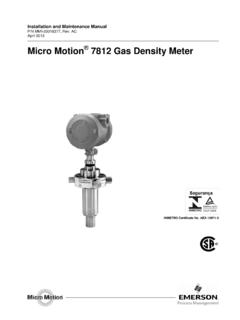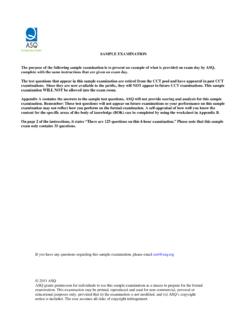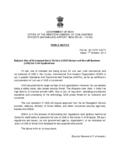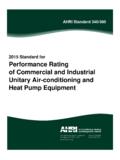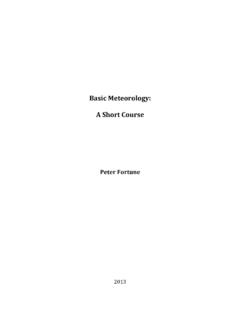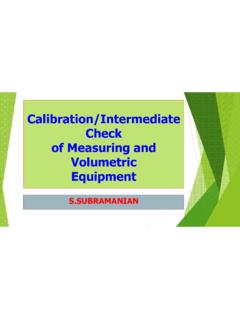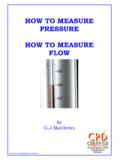Transcription of Standard Operating Procedures - Columbia University
1 Standard Operating Procedures1 Standard Operating Procedures OVERVIEWIn the following laboratory exercises you will be introduced to some of the glassware and tech-niques used by chemists to isolate components from natural or synthetic mixtures and to purify the individual compounds and characterize them by determining some of their physical proper-ties. While working collaboratively with your group members you will become acquainted with:a)Volumetric glasswareb)Liquid-liquid extraction apparatusc)Distillation apparatusOBJECTIVESA fter finishing these sessions and reporting your results to your mentor, you should be able to: Prepare solutions of exact concentrations Separate liquid-liquid mixtures Purify compounds by recrystallization Separate mixtures by simple and fractional distillation2 EXPERIMENT 1 Glassware Calibration, Primary and Secondary standards , and Manual TitrationsPART 1. Volumetric Glassware CalibrationVolumetric glassware is used to either contain or deliver liquids at a specified temperature.
2 Glassware manufacturers indicate this by inscribing on the volumetric ware the initials TC (to contain) or TD (to deliver) along with the calibration temperature, which is usually 20 C1. Volumetric glassware must be scrupulously clean before use. The presence of streaks or droplets is an indication of the presence of a grease film. To eliminate grease from glassware, scrub with detergent solution, rinse with tap water, and finally rinse with a small portion of distilled flasks (TC)A volumetric flask has a large round bottom with only one graduation mark positioned on the long narrow neck. Graduation MarkStopperThe position of the mark facilitates the accurate and precise reading of the meniscus. If the flask is used to prepare a solution starting with a solid compound, add small amounts of sol-vent until the entire solid dissolves. Cap the flask with its stopper and invert it three times to in-sure good mixing.
3 If the temperature changes during dissolution, wait until the flask reaches room temperature before proceeding to fill the flask to the Skoog , West , Analytical Chemistry, 2nd Ed, pp. 89-91, Holt, Rinehart and Winston (1965).3 When filling the volumetric flask, stop the transfer of liquid when the liquid level is about an inch below the graduation mark and invert the flask as you did previously to homogenize the solution. Then use a Pasteur pipette to add liquid slowly to the mark. Once liquid is filled to the mark, cap the flask with a stopper and mix as before. Overfilling the flask above the graduation mark ruins the volume measurement. In this case, the content inside the volumetric flask should be discarded. Pipettes (TD)A pipette bulb should be used to withdraw and deliver liquids when using a pipette. In this course you will use graduated and volumetric pipettes according to the precision required by the experiment.
4 Graduated pipettes deliver different amounts of liquid by making use of incre-mental markings inscribed along the pipette. Volumetric pipettes deliver fixed amounts of liquid indicated by a single graduation mark inscribed on them. The volumetric pipette possesses an enlarged portion below the graduation mark in order to reduce the speed of suction and allow a precise volume (TD)A burette is a long glass tube with a stopcock near the tip, which precisely controls the rate of flow of liquid down the constricted tip of the use, burettes must be rinsed first with distilled water, then with a small portion of the liquid to be measured as follows: add approximately 2 mL of liquid to the burette, hold the burette horizontally and rotate it to allow the liquid to coat the entire inside. Drain the liquid down the tip. When filling the burette using a funnel, make sure the funnel is perfectly clean, the stopcock is closed, and the burette is over a waste beaker.
5 If you see air bubbles trapped inside 4the tip of the burette, eliminate them by draining a few mL of the liquid out the tip while holding the burette diagonally. Your mentor will demonstrate the correct way to rinse and fill the on the type of glassware, the gravimetric calibration procedure at room tem-perature consists of:a)Determining the mass of distilled water that fills the TC-ware until the bottom of the menis-cus coincides with the graduation mark; or collecting the amount of water delivered by the TD-ware in a tared beaker. Repeat the procedure at least three times to assure reproducibil-ity. b)Measure the exact temperature of the water with a C precision thermometer before each )Calculate the calibrated volume using the density of water at the calibration temperature (Knovel Critical Tables )Warning: The Mettler balance has a capacity of Analysis of DataYour group will be assigned 4 or 5 pieces of glassware to calibrate.
6 Each group member should calibrate one piece of glassware. Your mentor will give you instructions about the volumes to measure. Input the data from your notebook into the spreadsheet that corresponds to each piece of the name of the manufacturer. Fill up the information as in the example below. VOLUMETRIC FLASKM easured Volume (mL)Measured mass (g) Temperature of water ( C)Density (g/mL)Calculated vol-ume (mL) Excel compute the average, variance, and Standard deviation for each piece of glassware. Compute the same statistics for the mass determined with the Mettler the uncertainty given by the glassware manufacturer and by the Mettler the values of the computed statistic with the uncertainty provided by the manufacturers. Comment on the statistics given by the the precision of the calibrated volume for each piece of glassware and for the Mettler your conclusionsPART 2. Solution Preparation: Primary and Secondary two watch glasses and weigh on each a small amount of sodium hydroxide, NaOH and potassium hydrogen phthalate, KHP, a monoprotic acid.
7 Record the masses to the nearest 1 mg. Leave the systems exposed to air for 25 minutes. you are waiting for the watch glass systems, take a 400 mL beaker of distilled water and measure the pH of the water. Is this the value you expect? Boil the distilled water un-covered with a stir bar for 10 minutes and let it cool to room temperature covered with a watch glass. Measure the pH again. Is there a difference in the reading obtained? If so, discuss why. time has elapsed, weigh the watch glasses and record your observations. Based on the observations you made, decide which one of the two substances can be weighed di-rectly and dissolved in a well-measured volume of water to prepare a solution of exact a 10-1M solution of the substance you decided on in step the volume needed from this concentrated solution to prepare 250 mL of a 10-2M solution. Use a volumetric pipette to withdraw the aliquot calculated from the concen-trated solution.
8 Is it OK to use a graduated pipette to take the aliquot? Set this solution aside to determine its exact concentration 3. Standardization of Sodium Hydroxide SolutionAfter preparing a solution with the substance that changed while exposed to air, it is necessary to perform a standardization (find the exact concentration of the solution) using a procedure called TITRATION. The solution should be kept minimally exposed to air after standardization. The TITRATION procedure entails reacting a volume of a solution whose concentration is exactly 6known or a mass of solid with known molecular weight with a volume of a solution which con-centration is unknown. The volume of sodium hydroxide solution used in a manual titration is the volume needed to reach the endpoint of the titration (where the indicator changes color), while the one obtained from the potentiometric titration is referred to as the equivalence point of the titration.
9 At the equivalence point the number of moles of titrant used is equal to the number of moles of the titrated compound. about 450 mL of distilled water to about 150 mL of NaOH (aq) solution provided (note the approximate concentration of the NaOH(aq) from the bottle). Cover the bottle and homogenize. Neither of these volumes needs to be exact since the solution will be standardized. Keep the dilute solution covered as much as possible. two samples of about g of KHP (Potassium Hydrogen Phthalate, record exactly the amount of KHP weighed) and quantitatively transfer them into two separate, clean 250 mL Erlenmeyer flasks. Dissolve the samples in about 100 mL distilled water (you may need to slightly heat for complete dissolution, but make sure the solutions cool to room temperature before titrating) and add 2-3 drops of phenolphthalein a clean burette with distilled water and then with small portions of the dilute solu-tion prepared in step 1.
10 Discard the rinse solutions in the liquid waste container and clamp the burette to the burette clamp. Fill the burette with the dilute solution prepared in step 1. the exact amount of KHP and its molar mass ( g/mol), can you estimate the approximate volume of dilute sodium hydroxide solution needed to reach the end-point of the titration? the KHP solution with the diluted NaOH solution from the burette, swirling con-tinuously, until the faint pink color lasts about 20 seconds. Each group member should perform at least one manual titration. the concentration of the solution from the volume used in each titration. If the values of the volume used for each titration fall within the experimental error, use the av-erage value as the concentration of the solution. If the values are scattered showing low precision, repeat the titration one more time. 7 RESULTSP rimary versus non-primary standardTime(min)Mass NaOH (g)Mass KHP (g)025 Observations:Standardization of NaOHManual TitrationTrial 1 Trial 2 Trial 3 Weight of KHP used (g)Initial burette reading (mL)Final burette reading (mL)Volume NaOH used (mL)DISCUSSIOND iscuss with your group whether the endpoint volume of the equivalence point should be used to calculate the concentration of the titrated sodium hydroxide solution.










